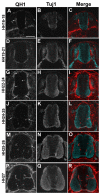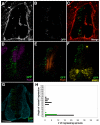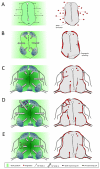Neurovascular development uses VEGF-A signaling to regulate blood vessel ingression into the neural tube
- PMID: 19176586
- PMCID: PMC2685948
- DOI: 10.1242/dev.028845
Neurovascular development uses VEGF-A signaling to regulate blood vessel ingression into the neural tube
Abstract
Neurovascular development requires communication between two developing organs, the neuroepithelium and embryonic blood vessels. We investigated the role of VEGF-A signaling in the embryonic crosstalk required for ingression of angiogenic vessel sprouts into the developing neural tube. As the neural tube develops, blood vessels enter at specific points medially and ventrally from the surrounding perineural vascular plexus. Localized ectopic expression of heparin-binding VEGF165 or VEGF189 from the developing avian neural tube resulted in supernumerary blood vessel ingression points and disrupted vessel patterning. By contrast, localized ectopic neural expression of non-heparin-binding VEGF121 did not produce supernumerary blood vessel ingression points, although the vessels that entered the neural tube became dysmorphogenic. Localized loss of endogenous VEGF-A signaling in the developing neural tube via ectopic expression of the VEGF inhibitor sFlt-1 locally blocked blood vessel ingression. The VEGF pathway manipulations were temporally controlled and did not dramatically affect neural tube maturation and dorsal-ventral patterning. Thus, neural-derived VEGF-A has a direct role in the spatially localized molecular crosstalk that is required for neurovascular development and vessel patterning in the developing neural tube.
Figures







Similar articles
-
Angiogenesis in the developing spinal cord: blood vessel exclusion from neural progenitor region is mediated by VEGF and its antagonists.PLoS One. 2015 Jan 13;10(1):e0116119. doi: 10.1371/journal.pone.0116119. eCollection 2015. PLoS One. 2015. PMID: 25585380 Free PMC article.
-
The neural tube patterns vessels developmentally using the VEGF signaling pathway.Development. 2004 Apr;131(7):1503-13. doi: 10.1242/dev.01039. Epub 2004 Mar 3. Development. 2004. PMID: 14998923
-
VEGF-directed blood vessel patterning: from cells to organism.Cold Spring Harb Perspect Med. 2012 Sep 1;2(9):a006452. doi: 10.1101/cshperspect.a006452. Cold Spring Harb Perspect Med. 2012. PMID: 22951440 Free PMC article. Review.
-
Cadherin-7 enhances Sonic Hedgehog signalling by preventing Gli3 repressor formation during neural tube patterning.Open Biol. 2017 Dec;7(12):170225. doi: 10.1098/rsob.170225. Open Biol. 2017. PMID: 29263249 Free PMC article.
-
Blood vessel patterning at the embryonic midline.Curr Top Dev Biol. 2004;62:55-85. doi: 10.1016/S0070-2153(04)62003-5. Curr Top Dev Biol. 2004. PMID: 15522739 Review.
Cited by
-
The Roles of TGF-β Signaling in Cerebrovascular Diseases.Front Cell Dev Biol. 2020 Sep 18;8:567682. doi: 10.3389/fcell.2020.567682. eCollection 2020. Front Cell Dev Biol. 2020. PMID: 33072751 Free PMC article. Review.
-
Translational control in neurovascular brain development.R Soc Open Sci. 2021 Oct 13;8(10):211088. doi: 10.1098/rsos.211088. eCollection 2021 Oct. R Soc Open Sci. 2021. PMID: 34659781 Free PMC article. Review.
-
Potential of Neural Stem Cell-Based Therapy for Parkinson's Disease.Parkinsons Dis. 2015;2015:571475. doi: 10.1155/2015/571475. Epub 2015 Nov 17. Parkinsons Dis. 2015. PMID: 26664823 Free PMC article. Review.
-
Semaphorin-PlexinD1 signaling limits angiogenic potential via the VEGF decoy receptor sFlt1.Dev Cell. 2011 Aug 16;21(2):301-14. doi: 10.1016/j.devcel.2011.06.033. Epub 2011 Jul 28. Dev Cell. 2011. PMID: 21802375 Free PMC article.
-
Excessive vascular sprouting underlies cerebral hemorrhage in mice lacking αVβ8-TGFβ signaling in the brain.Development. 2014 Dec;141(23):4489-99. doi: 10.1242/dev.107193. Epub 2014 Nov 18. Development. 2014. PMID: 25406396 Free PMC article.
References
-
- Aitkenhead, M., Christ, B., Eichmann, A., Feucht, M., Wilson, D. J. and Wilting, J. (1998). Paracrine and autocrine regulation of vascular endothelial growth factor during tissue differentiation in the quail. Dev. Dyn. 212, 1-13. - PubMed
-
- Ambler, C. A., Nowicki, J. L., Burke, A. C. and Bautch, V. L. (2001). Assembly of trunk and limb blood vessels involves extensive migration and vasculogenesis of somite-derived angioblasts. Dev. Biol. 234, 352-364. - PubMed
-
- Ambler, C. A., Schmunk, G. A. and Bautch, V. L. (2003). Stem cell-derived endothelial cells/progenitors migrate and pattern in the embryo using the VEGF signaling pathway. Dev. Biol. 257, 205-219. - PubMed
-
- Carmeliet, P. and Tessier-Lavigne, M. (2005). Common mechanisms of nerve and blood vessel wiring. Nature 436, 193-200. - PubMed
-
- Carmeliet, P., Ferreira, V., Breier, G., Pollefeyt, S., Kieckens, L., Gertsenstein, M., Fahrig, M., Vandenhoeck, A., Harpal, K., Eberhardt, C. et al. (1996). Abnormal blood vessel development and lethality in embryos lacking a single VEGF allele. Nature 380, 435-439. - PubMed
Publication types
MeSH terms
Substances
Grants and funding
LinkOut - more resources
Full Text Sources
Research Materials

